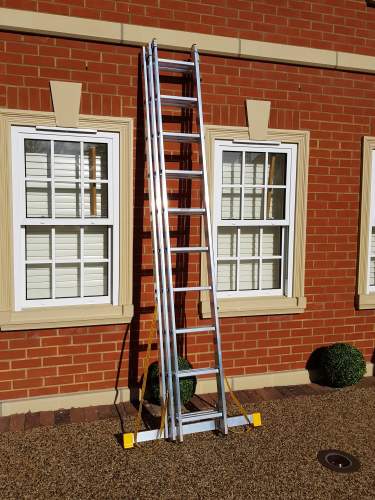When spending so much time at home like many of us have been doing throughout the coronavirus pandemic it can be tempting to sort out any niggling DIY issues around the house or garden. Perhaps there are things you would usually have a tradesperson or family member do that you are wanting to do yourself. If you are not used to completing DIY or using ladders it can be dangerous to just start climbing and hope for the best. You risk injuring yourself or misusing the ladder which could lead to quick deterioration and damage. By reading this guide you will avoid those risks and know precisely how to use your ladder correctly and safely so you can get peace of mind and complete those little annoying jobs.
Before you even consider using the ladder you should…
This isn’t some bizarre guide where I tell you the tool is an extension of yourself and you should be at one with the ladder so you know how to wield it or anything like that (I know that sounded like a bad film premise but you can see my point). However, what I am going to say is you must feel confident in using the ladder before you even take it out of your garage or loft. If you don’t feel confident using the ladder then you shouldn’t, you can always come back to it (maybe after reading this advice) when you know you can use it correctly and ensure your own safety.
The other key thing to remember before using the ladder is you need to inspect it first. Even people who use ladders regularly can forget to do this, but you may not notice a small area of damage that could result in you falling off the ladder and hurting yourself. Whether your ladder gets used daily or rarely it’s important to check it before every use. The checks include looking for damage on the sides, steps, and testing the locking mechanisms are functioning as they should be.
Lean in and learn how to position your ladder
One of the most traditional ladders that is used for DIY or anything around the house is the leaning ladder, you must lean it against a wall to use it correctly. There are many examples of leaning ladders on the market including extension ladders, multi-purpose ladders and telescopic ladders. If you’re looking for a new ladder check out our selection at BPS, you can get an amazing deal on high quality ladders.
You must lean your ladder at the best angle before you start climbing it otherwise it could become unstable and collapse which is the most common accident in ladder use. The HSE has recommended that ladders should be placed at a 76-degree angle to prevent tipping and sliding. You should never attempt to adjust the angle to try and get a higher or lower height, it should be able to sit comfortably so you can reach the height you need without adjustments.
Also, you should never try to gain extra height by balancing your ladder on top of objects such as bricks or pallets. Again, you would be compromising your stability and safety as ladders are designed to be placed on a solid and flat surface.
Yes, there is a right way to climb a ladder
It may seem obvious and it’s not meant to be patronising but there is a correct way to climb a ladder to maximise your safety. You should use both hands to climb the ladder, one on each side of the rungs, ensuring the ladder is facing you. If your DIY job requires tools such as for painting or gardening then wear a tool belt if you can rather than trying to hold them in your hand whilst you climb as you need to have a firm grip on the ladder. Once you have climbed you should let go as briefly as possible to carry out your job and you shouldn’t use the last three rungs of the ladder.
Don’t be over keen when you lean
Whilst it’s important to be confident when using ladders that doesn’t mean take reckless risks. If you find that you’re having to lean too far to try and complete your job then you should climb down and move the ladder into a better position nearer to the area you’re working on. There is a way to tell whether you are leaning too far, the ‘belt buckle test’. If your belt buckle is outside the rung area of the ladder, then you are leaning too far and run the risk of slipping and falling. This could also happen if you stretch too far upwards as you can throw off your balance so be mindful of that.
Avoid piling on the pounds
All ladders come with a weight capacity and you should check this in the manufacturer’s instructions before you start to use it if you are going to have a lot of tools or materials on the ladder for your DIY job. Remember they can be heavier than you think, and you must account for your own weight with them. Most of our ladders have a maximum weight of 23.5 stone, so you’ll have plenty of excess for tools and materials on top of your own weight. Keep in mind how much you’re carrying though because too much stuff could affect your balance even if it’s under the maximum capacity.
So that is the end of our time together in this guide, I hope you have had food for thought or at least learnt something you didn’t know before about using ladders correctly when carrying out DIY. If you’re on the lookout for a new ladder, then you should check out our range. We will have a ladder to suit any needs you have, and you could grab yourself a bargain as we frequently have special offers on our ladders. Find out more today and don’t miss out!
No related posts.



